SEEN
Random International: Rain Room
4 October 2012 - 3 March 2013, Barbican, The Curve
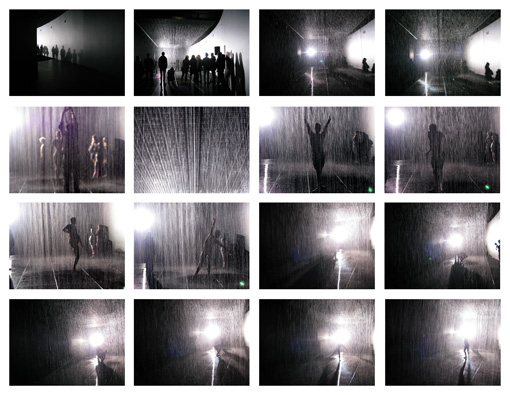
Experience a unique fusion of art and movement as dancers perform continuously evolving interventions inside Rain Room.
More than the technical virtuosity necessary for its success, the piece relies on a sculptural rigour, with the entire Curve transformed by the monumental proportions of this carefully choreographed downpour and the sound of water. Random International are known for their distinctive approach to digital-based contemporary art. Their experimental artworks come alive through audience interaction and staged performance.
Random International are represented by Carpenters Workshop Gallery, London and Paris.
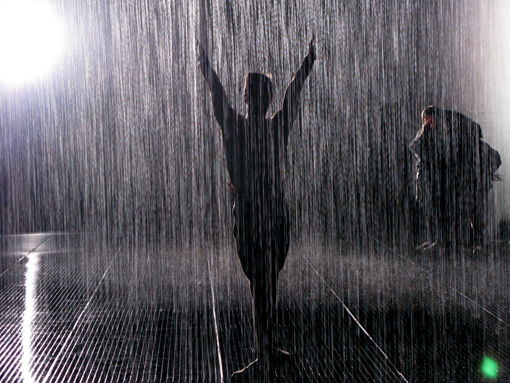
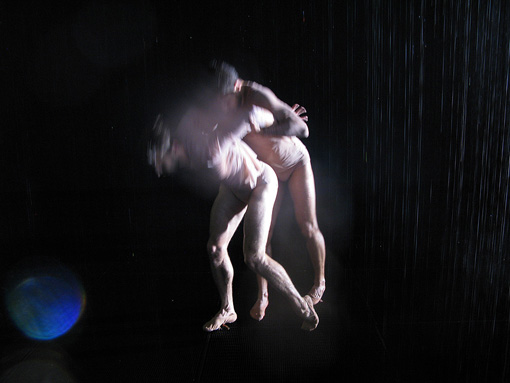
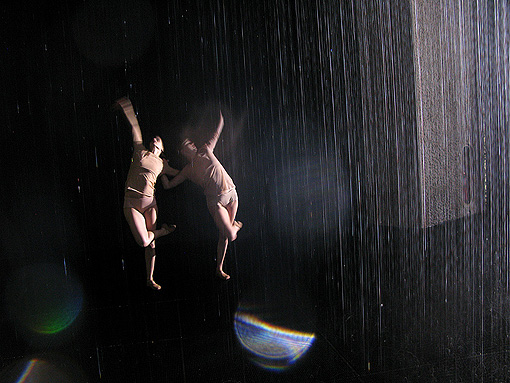
Liverpool Biennial
Bloomberg New Contemporaries 2012
15 September - 25 November 2012, LJMU Copperas Hill Building, Liverpool
New Contemporaries is the leading UK organisation supporting emergent art practice from British Art Schools. Since 1949 New Contemporaries has consistently provided a critical platform for new and recent fine art graduates primarily by means of an annual, nationally touring exhibition.
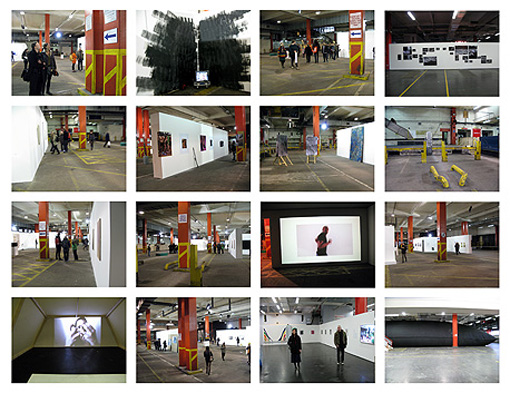
photos Eleonora Bourmistrov
MARIKO MORI: REBIRTH
13 December 2012 - 17 February 2013 at Royal Academy, London
In her work, Mariko Mori addresses the cycle of life from birth to death and back again - so in the sculpture "Tom Na H-lu II (2006), a star has died to make a glass menhir;. Its pulsing inner lights are powered by cosmic rays and neutrino bursts or supernova, which are beamed as data from an observatory in Tokyo and translated into ethereal green, pink, yellow or blue afterglows.
"Since her first exhibitions in the mid-1990s, Mori’s practice has been rooted in both traditional and contemporary Japanese culture, and between East and West. Her works juxtapose contrasting aesthetic languages that have ranged from traditional tea ceremonies to Manga and cyber culture, fusing Shintoism and Buddhism with the hard planes of science and technology. Mori’s recent practice has evolved around a fascination with ancient cultures, among them prehistoric Jomon (c.14,000 – 300 BC) in Japan and Celtic traditions in Europe. Founded on a belief in cycles of death and rebirth, these were marked by a holistic world view that placed mankind in a more harmonious relationship with our surroundings. These interests are expressed through emerging technologies and digital media, which the artist embraces as tools to be harnessed in order to reconnect with our environment." - from RA introduction to the exhibition.
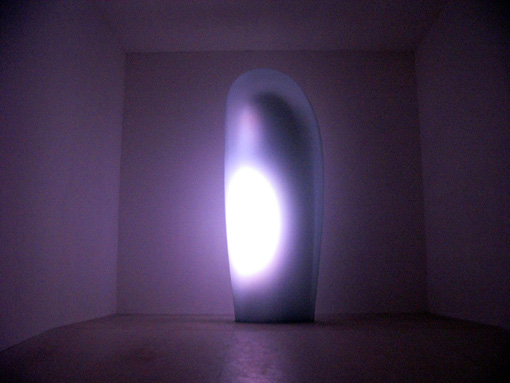 photo: Eleonora Bourmistrov
photo: Eleonora Bourmistrov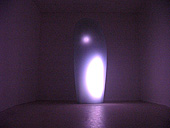
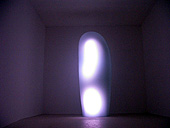
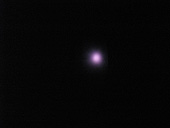
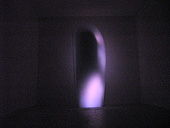
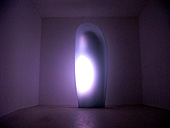


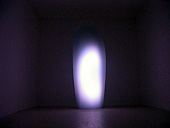
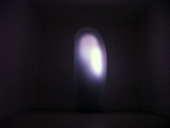 Tom Na H-lu II, Glass
Tom Na H-lu II, Glass
photos Eleonora Bourmistrov
BRUCE NAUMAN: MINDFUCK
30 January - 8 March 2013, Hauser & Wirth London
"To speak about the work of Bruce Nauman in the language of psychoanalytic theory is a complex task, given the heterogeneity of his production and the variety of schools of psychoanalytic thought. How is it that the critical discourse surrounding a body of work whose central themes are human nature, the mind-body split, language, sex, death, and aggression, has repressed its obvious psychoanalytic and psychological implications? The experience of certain works by Nauman approximates a state of trauma, equivalent to the conversion symptoms of the hysteric, to the utterances of the psychotic, to the repetition compulsion tied to the death drive, to the reprimands of the superego, to good and bad internal objects, and to the logic of dreams. Undergirding all of his work is an uncanny ability to create visual and experiential equivalents for metapsychology and to tap into the deep structure of the human unconscious.
The exhibition’s title, ‘mindfuck’, is a slang term that may be used as both a noun and verb, situation and action. It can mean to brainwash or manipulate someone, or describe a distressing situation or incomprehensible event. A ‘mindfucker’ is anyone who makes a living by playing with the heads of his clientele, be it a guru, a psychoanalyst, a prostitute, or an artist. Like Nauman’s deceptively simple phrases, which turn on puns and reversals and often defy rational understanding, the vernacular ‘mindfuck’ distills in a single word the dichotomies and aporias that the exhibition proposes to explore, literally yoking together the rational and the intuitive, the verbal and the unutterable, the abstract and the physical." (Press Release)
‘
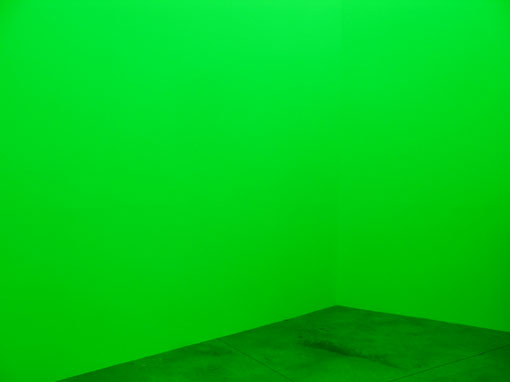 Green Room
Green Room
Green Room Corridor to Sex & Death / Double 
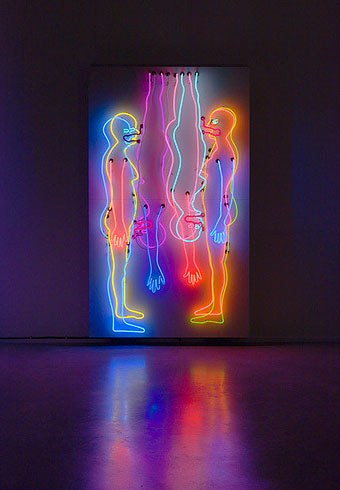 Sex & Death / Double, Neon tubing on Aluminium Monolith
Sex & Death / Double, Neon tubing on Aluminium Monolith
29 May - 21 July 2013, Matt's Gallery, London

Jordan Baseman, The Last Walk, 2011. Installation photograph by Peter White courtesy the artist and Matt's Gallery, London.
Press Information
Deadness is an exhibition of three parts: multiple 35mm slide projections with sound, the film The Last Walk (2011) and February 09 2013, a series of new photographic works.
Deadness is derived from Baseman’s creative non-fiction and interview-based practice, exploring the historical, cultural and sociological relationship between photographic portraiture and embalming, a theme investigated by Dr John Troyer, sociologist and Deputy Director of the Centre for Death and Society at the University of Bath.
Dr Troyer grew up around funeral homes prior to his academic engagement with the subject of embalming, witnessing first-hand from a young age through his father’s work as a Funeral Director. Deadness presents his professional and personal connection to embalming combined with orphaned images collected through online auctions: casual snap shots and more formal portraits of individuals in their coffins from the early Victorian era to the present day.
The embalmer’s attention focuses on preparation for the moment relatives and loved ones view the deceased; this moment defines the core function of contemporary embalming: to leave the bereaved with a peaceful image and memory of the deceased. No matter how debilitating the trauma or the circumstances of a person’s death, this viewing is when the embalmer’s art is most clearly expressed.
Deadness acts as an experimental portrait of contemporary embalming, processes of reconstruction, preparation for burial (on land and sea) and cremation; providing insight into these private practices and the debates surrounding them. The exhibition partially focuses on the embalmer’s attempts to make the deceased appear to be at peace - as if asleep - thus prolonging the image of being alive and promoting positive final memories. The hope is that these memories will replace images of seen (as well as unseen or perceived) trauma, lingering death and/or prolonged disease. The processes of physical restoration and cosmeticising the deceased are perhaps the most crucial elements of embalming, making the main focus of this series of processes the return of the cadaver to its ‘natural’ appearance for viewing. Deadness explores the philosophical thrust of these processes as ideas and their meanings within our culture today.
February 09 2013 is a series of images captured at the base of wildfires in Tasmania, Australia on the 9th of February 2013. Although there were no deaths recorded on this date, the constant threat was ever-present.
The Last Walk features British artist Stuart Brisley. What starts as an ordinary walk in the park for Brisley and his dog soon ends in a dark discovery. The film, recorded on the final day of a Christmas fair in central London depicts fragments of reflected fairy lights suspended in winter trees.
In The Last Walk, the colour negative was hand-processed using the most rudimentary techniques possible: chemicals were housed in buckets in a simple, totally blacked out space to encourage visual breakdown, fragmentation and distortion- pushing the unpredictable nature of the materiality of film itself at its most fundamental level. The combination of filmed information and hand - processing create a mixture of abstraction and representation.
ANA MENDIETA: TRACES
24 September 2013 - 15 December 2013, Hayward Gallery
Using her own body, together with elemental materials such as blood, fire, earth and water, Ana Mendieta creates visceral performances and ephemeral ‘earth-body’ sculptures that combine ritual with metaphors about life, death, rebirth and spiritual transformation. ‘I wanted my images to have power, to be magic,’ she said. ‘I decided that for the images to have magic qualities I had to work directly with nature.’
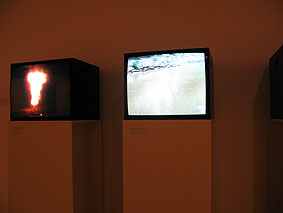

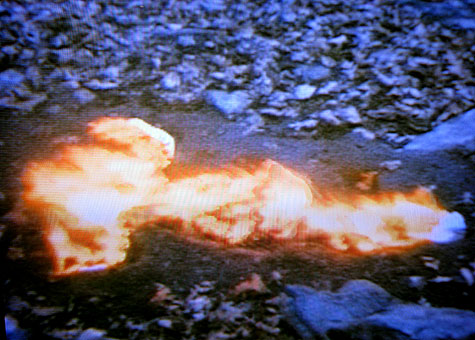

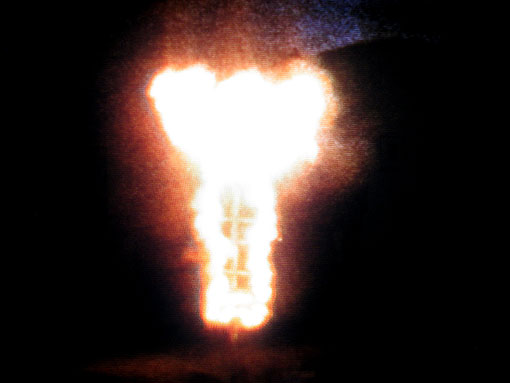
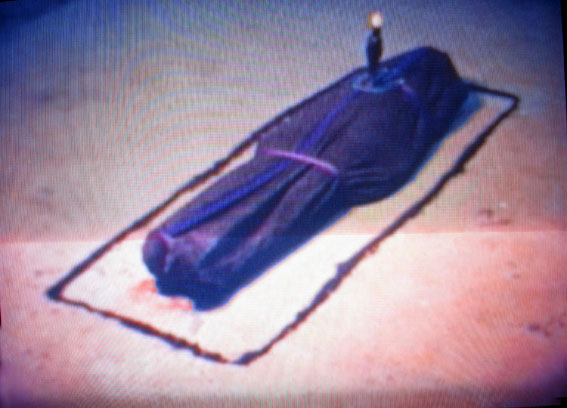
photos: Eleonora Bourmistrov
Ana Mendieta: death of an artist foretold in blood
The mystery of how the Cuban artist Ana Mendieta fell 34 floors from the window of her New York apartment in 1985 has echoes in the dark, ritualistic images she left behindSean O'Hagan
The Observer, Sunday 22 September 2013:
In 1992, the Guggenheim Museum in New York held the inaugural show for its new – and what would turn out to be short-lived – downtown art gallery in SoHo. The opening was memorable not for the art within, but the action outside. To enter the exhibition the great and the good of the New York art world had to pass a picket line of about 500 feminist protesters, many of them carrying banners that read: "Where Is Ana Mendieta?"
That question was directed at the male-dominated art establishment, which feminists claimed had already forgotten Ana Mendieta, who had died seven years earlier. What incensed the protesters even more was the inclusion in the show of a work by her former partner, the minimalist sculptor Carl Andre. To them, as well as to Mendieta's family and many of her friends, Andre was responsible for her death.
In the early hours of 8 September 1985, Mendieta had – to borrow the words Andre had used when he called the emergency services – "somehow gone out the window" of their 34th floor apartment on Manhattan's Mercer Street.
Both had been drinking heavily. Andre later claimed to remember nothing of the events leading up to her death and that she may even have committed suicide, but those that knew her well – and knew of her acute fear of heights – thought this unlikely. Many of them believed he had pushed or even thrown her out of the window during a drunken argument.
"What happened that night, no one will ever know," says the artist Ted Victoria, a close friend of Mendieta who still lives and works in a studio in SoHo close to where she first lived after arriving in New York. "But the notion that she would jump out the window in her underwear – no. She had too much going for her at the time, more so than him. Her work was being noticed. And she wasn't depressed.
"I know because I saw her a few nights before her death. She was up and happy. She hated heights, so she would not have climbed up on the window, which was close to, and just above, the bed in their apartment. My guess is they were fighting and it just happened, this terrible thing."
"Most people thought he had done something active," says Dotty Attie, an artist and friend of Mendieta from when they both belonged to the all-women AIR gallery in New York in the early 1980s. "Others, who knew him, could not believe it. Most of his women friends supported him, but people wanted to blame somebody. There was a lot of division in the New York art world over her death. People took sides."
When the police arrived, they found the couple's bedroom in a mess and Andre with scratch marks on his nose and arms. His initial statements differed from his recorded message to the emergency services. He was arrested and later charged with murder. In court, a doorman testified that he heard a woman screaming "No" several times around 5.30am, and then the thud of her body as it hit the roof of the all-night delicatessen below.
After three separate indictments, Andre was acquitted on the grounds that there was insufficient evidence to prove that he had pushed her during a drunken row. Many of her friends remain unconvinced of his innocence. They cite contradictions in his police interviews, and his decision to be tried by a judge rather than a jury – which meant that the evidence was weighed up without him being cross-examined by the prosecution.
"There were too many things that were just not right about the trial," says the feminist writer and academic B Ruby Rich, a friend and staunch supporter of Mendieta, who wrote a long, critical article in the Village Voice newspaper following the failure of the first indictment. "Not least the cynical way in which his lawyers tried to use her art to back up the suggestion that she committed suicide. Many powerful figures in the New York art world colluded in that."
Until recently, the question asked by those feminist protesters might have been amended to "Who is Ana Mendieta?", so unknown was her art outside the rarefied world of feminist art criticism. But, as the recent big show of her work at the Whitney Museum in New York and the imminent retrospective at the Hayward gallery in London attests, Mendieta is undergoing a reappraisal as a pioneering artist whose work, as the Hayward's artistic director, Ralph Rugoff, notes "ranged nomadically across practices associated with body art, land art, performance, sculpture, photography and film".
Cuban-born and American-raised, Mendieta described her work as "earth-body" art. From 1971, when she had her first solo show while an MA student at the University of Iowa, until her death, she created a diverse collection of work that included silhouettes of her body created in mud, earth, rocks, wild flowers and leaves, performance pieces that evoked the folk and occult traditions of her native Cuba as well as her beloved Mexico and subversive self-portraits that played with notions of beauty, belonging and gender. In her performance pieces, where she sometimes used blood "as a very, powerful magical thing", she evoked the power of female sexuality as well as the horror of male sexual violence. In her photographic self-portraits, she pressed her face against glass to distort her features or pictured herself dripping in blood or disguised as a man with glued-on facial hair.
Mendieta's art, like her spirit, was fuelled by a restlessness rooted in her exile from Cuba. Friends described her variously as "sparky", "provocative", "tempestuous", "outspoken" and "fiercely ambitious." After her death, many saw, in her often dark and ritualistic art, a foreshadowing of her fate – she once staged a performance in which visitors came upon her prone under a blood-splattered white sheet. Others claimed her as the freest of female free spirits in a male-dominated art world. The curator and scholar Irit Rogoff, her as "essentialised through an association of wild appetites and with unbounded female sexuality." It is only now that the power of her art is finally taking precedence over the stereotypes that were thrust upon her and the darkly dramatic manner of her death.
Mendieta was born in November 1948, the second of three children to Ignacio and Raquel Mendieta, a well-off, upper-middle-class couple. Her father, a supporter of Fidel Castro, was made an assistant in the post-revolutionary ministry of state in 1959 but, disillusioned with the anti-Catholicism of the new Cuba, later became involved in organising counter-revolutionary activities. As did his two daughters, Ana and Raquelin, aged 12 and 14. Fearing for their safety, he arranged for their passage to America, in 1961 through Operation Pedro Pan, a scheme organised by a priest in Miami that allowed around 14,000 children to leave the country and enter the US under the guardianship of the Catholic church. "For Ana, it was an adventurous thing," her sister Raquelin later remembered, "When we arrived in Miami, she kissed the ground."
Her euphoria was short-lived. After a time in which they were given over to the care of an Iowa reform school, where beatings and confinement were common punishments for the slightest misdemeanour, the sisters were separated and spent several years being shunted from one foster home to another. Ana felt abandoned by her family and isolated from her homeland. She did not see her mother and brother again until 1966, or her father, who was jailed for disloyalty to Castro, until 1979. He died soon after arriving in America.
"You have to understand she came to America with nothing," says Victoria. "That sense of exile was something she carried with her as well as a fierce independence of spirit. She would talk about it sometimes when she'd had a few drinks. I mean, coming from the heat and fire of Cuba to puritan Iowa would leave its mark on anyone and she had that survivor's spirit.
"She was driven in everything she did and that made her feisty and combative as well as great and generous company."
Mendieta began making art at the University of Iowa, where she had a decade-long affair with the artist and academic Hans Breder, perhaps her most important formative influence. It was Breder who drew her attention to the notion of cross-disciplinary practice, citing the likes of Marcel Duchamp, Yves Klein and the Viennese actionists as creative touchstones as well as organising visits by contemporary avant garde artists such as Hans Haacke and Vito Acconci.
In the summer of 1971, Mendieta travelled to Mexico for research, describing the experience as "like going back to the source, being able to get some magic just by being there." Her vision – of a unified art of the self, drawing on nature and place as well as performance and sculpture – was being formed. Its first manifestation was also one of the rawest: a series of visceral performances created in response to the 1973 rape and murder of a university student, Sara Ann Otten.
By 1974, Mendieta was working on a series of performances that used blood as the primary material, including Body Tracks, in which she dips her hands and forearms in blood then smears them down a wall. Everything she did was documented on film or photographs, often by Breder.
In the summer of 1975, having returned to Mexico, she created the first of her Siluetas series in which she left an imprint of her body in the ground. Her silhouette pieces became a kind of signature, and were often executed in stones, leaves and twigs, flowers and driftwood, and sometimes set on fire, outlined by fireworks or drenched with red paint. "My art is grounded on the belief in one universal energy which runs though everything," she wrote in an artist's statement from the early 1980s, "from insect to man, from man to spectre, from spectre to plant, from plant to galaxy."
Rich, though, insists that Mendieta's art is as much rooted in the feminism of the time as any art tradition. "She came out of the feminist movement as much as Cuba. In the 1970s, blood was being reclaimed as a feminine – and a feminist – material in art. Plus her early earth works, particularly those made in Mexico, are very potent because they are made by a woman.
"People place her in the earth works tradition of Robert Smithson or Richard Long, but when a woman engages with the earth it is a very different statement. Her body was her art and she placed it in the ground. In doing so, she was trying to ground herself in the earth but also reconnect with the earth that she was standing on even if it was not Cuba."
Mendieta arrived in New York in 1978. She found a tiny apartment on Sullivan Street and eventually made friends with some of the leading feminist artists of the time, including Nancy Spero, Mary Beth Edelson and Carolee Schneemann. When Edelson organised a fancy-dress party for Louise Bourgeois, Mendieta went as Frida Kahlo. In 1979, also with Edelson's support, she joined the AIR all-women gallery on Wooster Street. "We didn't have a unifying agenda or way of thinking," says Attie, a founding member, "except that we wanted everything that men had in the art world. For most of us, that meant recognition."
It was through Spero that Mendieta met Andre. Their relationship intrigued some of their friends and baffled others: she was feisty and opinionated, small and sexy; he came across as cold and detached, his towering presence as formidable as his intellectual aloofness. "Carl and Ana were very different personalities and that is what attracted them to each other," says the Argentinian artist Liliana Porter, a friend of Mendieta. "Carl was very methodical in his daily life, following routines, and Ana was the opposite. He liked her strong personality, her looks and her intensity and she enjoyed his company and in some way needed a more mature and steady point of re ference."
Creatively, though, their art practices could not have been further apart: hers was wide-ranging, elemental and ritualistic; he was a minimalist whose work was refined and cerebral.(Andre is still best known in Britain for his infamous arrangement of 120 bricks at the Tate.) It is one of the ironies of her early death that her star was in the ascendancy as he was entering a period in which demand for his work fell and prices dipped accordingly. Often, when drink had been taken, she would taunt him about this, once saying, "You know, Carl, minimalism is over… you already did your thing." He would respond in kind.
"They drank a lot," remembers Victoria. "They would arrive around here for dinner with four or five bottles of champagne. There were arguments, mostly started by Ana. She was combative. She could bring out stuff that would really piss you off. That was just how she was when she was drunk. She had loads of attitude."
Attie concurs: "I had dinner with her and Carl in Rome and they both got very drunk. I remember her saying, 'Oh, he likes your work, but he's never bought anything.' It was mischievous and pointed and they went to it arguing. "But I didn't get the feeling he was ever violent. I remember she wanted to drive home and it was he who said no. He had self-control even when he was very drunk. I had a hard time thinking he would push her."
Mendieta moved to Rome in 1983 on a prestigious American Academy residency and fell in love with the city, describing it to friends as a cross between Cuba and New York. "She felt accepted there in a way she never was in America," says Rich. "She could be herself." For a while, her relationship with Andre hit the rocks, then, surprising everyone who knew them, they reunited and married in a private ceremony in Rome in January 1985. On her return to New York in August, though, she told friends she suspected him of having an affair in Berlin, where he had been working off and on.
On Thursday 5 September 1985, the couple had dinner with Spero and her husband, the painter Leon Golub. Spero later described them as "happy and relaxed". Three nights later, they stayed in to have a Chinese takeaway, watch a movie and drink champagne. The following day, she was found dead on the roof of the delicatessen, 33 floors below an open window of their apartment, her body having hit the surface so hard that her head left an imprint. Even her death echoed her art. "Ana was on her way somewhere else creatively when she was killed," says Rich, pointedly. "She was starting to make objects rather than ephemeral works. Stuff she could sell. She was excited and optimistic." Attie recalls meeting her in Rome earlier in the year and feeling the same. "She told me that she was making new work and that she was going to give up drinking and smoking because women artists did not get recognition until they were old. She said that she wanted to live long enough to savour it."